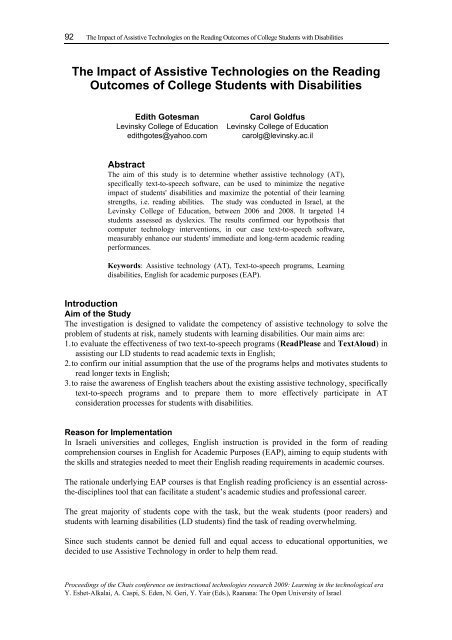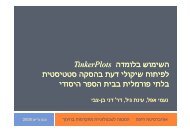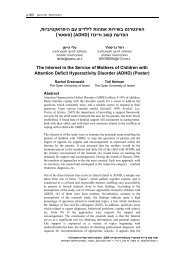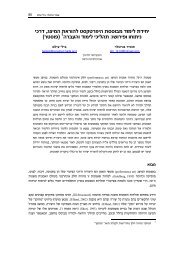The Impact of Assistive Technologies on the Reading Outcomes of ...
The Impact of Assistive Technologies on the Reading Outcomes of ...
The Impact of Assistive Technologies on the Reading Outcomes of ...
You also want an ePaper? Increase the reach of your titles
YUMPU automatically turns print PDFs into web optimized ePapers that Google loves.
92 <str<strong>on</strong>g>The</str<strong>on</strong>g> <str<strong>on</strong>g>Impact</str<strong>on</strong>g> <str<strong>on</strong>g>of</str<strong>on</strong>g> <str<strong>on</strong>g>Assistive</str<strong>on</strong>g> <str<strong>on</strong>g>Technologies</str<strong>on</strong>g> <strong>on</strong> <strong>the</strong> <strong>Reading</strong> <strong>Outcomes</strong> <str<strong>on</strong>g>of</str<strong>on</strong>g> College Students with Disabilities<br />
<str<strong>on</strong>g>The</str<strong>on</strong>g> <str<strong>on</strong>g>Impact</str<strong>on</strong>g> <str<strong>on</strong>g>of</str<strong>on</strong>g> <str<strong>on</strong>g>Assistive</str<strong>on</strong>g> <str<strong>on</strong>g>Technologies</str<strong>on</strong>g> <strong>on</strong> <strong>the</strong> <strong>Reading</strong><br />
<strong>Outcomes</strong> <str<strong>on</strong>g>of</str<strong>on</strong>g> College Students with Disabilities<br />
Edith Gotesman<br />
Levinsky College <str<strong>on</strong>g>of</str<strong>on</strong>g> Educati<strong>on</strong><br />
edithgotes@yahoo.com<br />
Carol Goldfus<br />
Levinsky College <str<strong>on</strong>g>of</str<strong>on</strong>g> Educati<strong>on</strong><br />
carolg@levinsky.ac.il<br />
Abstract<br />
<str<strong>on</strong>g>The</str<strong>on</strong>g> aim <str<strong>on</strong>g>of</str<strong>on</strong>g> this study is to determine whe<strong>the</strong>r assistive technology (AT),<br />
specifically text-to-speech s<str<strong>on</strong>g>of</str<strong>on</strong>g>tware, can be used to minimize <strong>the</strong> negative<br />
impact <str<strong>on</strong>g>of</str<strong>on</strong>g> students' disabilities and maximize <strong>the</strong> potential <str<strong>on</strong>g>of</str<strong>on</strong>g> <strong>the</strong>ir learning<br />
strengths, i.e. reading abilities. <str<strong>on</strong>g>The</str<strong>on</strong>g> study was c<strong>on</strong>ducted in Israel, at <strong>the</strong><br />
Levinsky College <str<strong>on</strong>g>of</str<strong>on</strong>g> Educati<strong>on</strong>, between 2006 and 2008. It targeted 14<br />
students assessed as dyslexics. <str<strong>on</strong>g>The</str<strong>on</strong>g> results c<strong>on</strong>firmed our hypo<strong>the</strong>sis that<br />
computer technology interventi<strong>on</strong>s, in our case text-to-speech s<str<strong>on</strong>g>of</str<strong>on</strong>g>tware,<br />
measurably enhance our students' immediate and l<strong>on</strong>g-term academic reading<br />
performances.<br />
Keywords: <str<strong>on</strong>g>Assistive</str<strong>on</strong>g> technology (AT), Text-to-speech programs, Learning<br />
disabilities, English for academic purposes (EAP).<br />
Introducti<strong>on</strong><br />
Aim <str<strong>on</strong>g>of</str<strong>on</strong>g> <strong>the</strong> Study<br />
<str<strong>on</strong>g>The</str<strong>on</strong>g> investigati<strong>on</strong> is designed to validate <strong>the</strong> competency <str<strong>on</strong>g>of</str<strong>on</strong>g> assistive technology to solve <strong>the</strong><br />
problem <str<strong>on</strong>g>of</str<strong>on</strong>g> students at risk, namely students with learning disabilities. Our main aims are:<br />
1. to evaluate <strong>the</strong> effectiveness <str<strong>on</strong>g>of</str<strong>on</strong>g> two text-to-speech programs (ReadPlease and TextAloud) in<br />
assisting our LD students to read academic texts in English;<br />
2. to c<strong>on</strong>firm our initial assumpti<strong>on</strong> that <strong>the</strong> use <str<strong>on</strong>g>of</str<strong>on</strong>g> <strong>the</strong> programs helps and motivates students to<br />
read l<strong>on</strong>ger texts in English;<br />
3. to raise <strong>the</strong> awareness <str<strong>on</strong>g>of</str<strong>on</strong>g> English teachers about <strong>the</strong> existing assistive technology, specifically<br />
text-to-speech programs and to prepare <strong>the</strong>m to more effectively participate in AT<br />
c<strong>on</strong>siderati<strong>on</strong> processes for students with disabilities.<br />
Reas<strong>on</strong> for Implementati<strong>on</strong><br />
In Israeli universities and colleges, English instructi<strong>on</strong> is provided in <strong>the</strong> form <str<strong>on</strong>g>of</str<strong>on</strong>g> reading<br />
comprehensi<strong>on</strong> courses in English for Academic Purposes (EAP), aiming to equip students with<br />
<strong>the</strong> skills and strategies needed to meet <strong>the</strong>ir English reading requirements in academic courses.<br />
<str<strong>on</strong>g>The</str<strong>on</strong>g> rati<strong>on</strong>ale underlying EAP courses is that English reading pr<str<strong>on</strong>g>of</str<strong>on</strong>g>iciency is an essential across<strong>the</strong>-disciplines<br />
tool that can facilitate a student’s academic studies and pr<str<strong>on</strong>g>of</str<strong>on</strong>g>essi<strong>on</strong>al career.<br />
<str<strong>on</strong>g>The</str<strong>on</strong>g> great majority <str<strong>on</strong>g>of</str<strong>on</strong>g> students cope with <strong>the</strong> task, but <strong>the</strong> weak students (poor readers) and<br />
students with learning disabilities (LD students) find <strong>the</strong> task <str<strong>on</strong>g>of</str<strong>on</strong>g> reading overwhelming.<br />
Since such students cannot be denied full and equal access to educati<strong>on</strong>al opportunities, we<br />
decided to use <str<strong>on</strong>g>Assistive</str<strong>on</strong>g> Technology in order to help <strong>the</strong>m read.<br />
Proceedings <str<strong>on</strong>g>of</str<strong>on</strong>g> <strong>the</strong> Chais c<strong>on</strong>ference <strong>on</strong> instructi<strong>on</strong>al technologies research 2009: Learning in <strong>the</strong> technological era<br />
Y. Eshet-Alkalai, A. Caspi, S. Eden, N. Geri, Y. Yair (Eds.), Raanana: <str<strong>on</strong>g>The</str<strong>on</strong>g> Open University <str<strong>on</strong>g>of</str<strong>on</strong>g> Israel
Edith Gotesman, Carol Goldfus<br />
93<br />
Research <strong>on</strong> <str<strong>on</strong>g>Assistive</str<strong>on</strong>g> Technology and Learning Disabilities<br />
<str<strong>on</strong>g>The</str<strong>on</strong>g> use <str<strong>on</strong>g>of</str<strong>on</strong>g> technology has been shown to be effective in a wide range <str<strong>on</strong>g>of</str<strong>on</strong>g> c<strong>on</strong>tent areas (Asht<strong>on</strong>,<br />
2005; Edyburn, 2004; Okolo, Cavalier, Ferretti, & MacArthur, 2000).Research says that use <str<strong>on</strong>g>of</str<strong>on</strong>g><br />
<str<strong>on</strong>g>Assistive</str<strong>on</strong>g> Technology (AT) can c<strong>on</strong>tribute to streng<strong>the</strong>ning students' skills in decoding,<br />
comprehensi<strong>on</strong> and reading with fluency (Elkind, Cohen, & Murray 1993, Higgins &<br />
Raskind, 2000), word recogniti<strong>on</strong>, reading comprehensi<strong>on</strong>, spelling and reading strategies<br />
(Raskind & Higgins, 1999), spelling (Dalt<strong>on</strong>, Winbury, & Morocco, 1990, MacArthur, Graham,<br />
Haynes, & DeLapaz, 1996), organizing, reading and syn<strong>the</strong>sizing informati<strong>on</strong> (Anders<strong>on</strong>,<br />
Inman, Knox-Quinn, & Homey, 1996, Anders<strong>on</strong>, Inman, Knox-Quinn, & Szymanski, 1999),<br />
pro<str<strong>on</strong>g>of</str<strong>on</strong>g>reading (Raskind & Higgins, 1995) and writing (Raskind & Higgins, 1995). AT has<br />
proved effective in assisting LD students perform better and more accurately, gain knowledge<br />
and c<strong>on</strong>fidence, gain independence in performing tasks, achieve better.<br />
To set <strong>the</strong> c<strong>on</strong>text, we will start by briefly examining <strong>the</strong> definiti<strong>on</strong>s <str<strong>on</strong>g>of</str<strong>on</strong>g> learning disabilities,<br />
dyslexia and AT.<br />
Learning Disabilities<br />
<str<strong>on</strong>g>The</str<strong>on</strong>g> term learning disability (LD) (Wikipedia) refers to "a group <str<strong>on</strong>g>of</str<strong>on</strong>g> disorders that affect a<br />
broad range <str<strong>on</strong>g>of</str<strong>on</strong>g> academic and functi<strong>on</strong>al skills including <strong>the</strong> ability to speak, listen, read, write,<br />
spell, reas<strong>on</strong> and organize informati<strong>on</strong>".<br />
Students who have dyslexia, a reading disability, or a disability in being able to read fluently<br />
<str<strong>on</strong>g>of</str<strong>on</strong>g>ten find reading texts extremely difficult in <strong>the</strong> L1, and almost, if not, impossible in English as<br />
a foreign language. Our goal in <strong>the</strong> college has been to provide <strong>the</strong>se students, who have been<br />
diagnosed as having dyslexia and o<strong>the</strong>r language-related difficulties with <strong>the</strong> possibility <str<strong>on</strong>g>of</str<strong>on</strong>g><br />
learning to read fluently and cope with <strong>the</strong> texts to achieve reading fluency.<br />
<str<strong>on</strong>g>Assistive</str<strong>on</strong>g> Technology<br />
<str<strong>on</strong>g>Assistive</str<strong>on</strong>g> Technology (AT) is defined by Raskind and Higgins (1998) as “any technology that<br />
enables an individual with a learning disability to compensate for specific deficits". AT covers a<br />
wide range <str<strong>on</strong>g>of</str<strong>on</strong>g> s<str<strong>on</strong>g>of</str<strong>on</strong>g>tware which helps students read, write, organize informati<strong>on</strong> and spell.<br />
Tables 1 and 2 present <strong>the</strong> way AT can be used to assist specific needs and show examples <str<strong>on</strong>g>of</str<strong>on</strong>g><br />
various existing s<str<strong>on</strong>g>of</str<strong>on</strong>g>tware.<br />
Specific Need<br />
Decoding (sounding out words)<br />
<strong>Reading</strong> comprehensi<strong>on</strong><br />
Handwriting<br />
Directi<strong>on</strong>ality<br />
Expressing words in written form<br />
Encoding (spelling)<br />
Organizati<strong>on</strong><br />
Table 1. Matching AT to students' specific needs<br />
<str<strong>on</strong>g>Assistive</str<strong>on</strong>g> Technology<br />
Text-to-speech programs<br />
Speech-to-text programs<br />
Word processors<br />
Word predicti<strong>on</strong> programs<br />
Pro<str<strong>on</strong>g>of</str<strong>on</strong>g>reading programs<br />
Spell checkers<br />
Outlining/brainstorming programs
94 <str<strong>on</strong>g>The</str<strong>on</strong>g> <str<strong>on</strong>g>Impact</str<strong>on</strong>g> <str<strong>on</strong>g>of</str<strong>on</strong>g> <str<strong>on</strong>g>Assistive</str<strong>on</strong>g> <str<strong>on</strong>g>Technologies</str<strong>on</strong>g> <strong>on</strong> <strong>the</strong> <strong>Reading</strong> <strong>Outcomes</strong> <str<strong>on</strong>g>of</str<strong>on</strong>g> College Students with Disabilities<br />
Type<br />
Difficulty<br />
<strong>Reading</strong><br />
Writing<br />
Planning and<br />
Organizati<strong>on</strong><br />
Spelling and<br />
Word<br />
Predicti<strong>on</strong><br />
Table 2. AT according to types <str<strong>on</strong>g>of</str<strong>on</strong>g> difficulty/impairment<br />
<str<strong>on</strong>g>of</str<strong>on</strong>g> AT to C<strong>on</strong>sider Internet Site<br />
ReadPlease<br />
Natural Reader<br />
TextAloud<br />
TextAssist<br />
Kurtzweil<br />
Drag<strong>on</strong>Naturally<br />
Speaking<br />
Intellitalk<br />
Inspirati<strong>on</strong><br />
WordQ<br />
Predictor Pro<br />
www.readplease.com<br />
www.naturalreader.com<br />
www.textaloud.com<br />
www.textassist.com<br />
http://www.kurzweiledu.com<br />
http://www.nuance.com/naturallyspeaking<br />
http://www.intellitools.com<br />
http://www.inspirati<strong>on</strong>.com<br />
http://www.wordq.com<br />
http://www.readingmadeez.com/products/PredictorPro.html<br />
Benefits <str<strong>on</strong>g>of</str<strong>on</strong>g> AT<br />
AT increases students' independence, builds <strong>the</strong>ir self-esteem and enhances <strong>the</strong>ir motivati<strong>on</strong> to<br />
actively participate in academic study and improve <strong>the</strong>ir reading performance. It helps students<br />
develop independent work strategies and organizati<strong>on</strong>al skills. It endows students with life-l<strong>on</strong>g<br />
learning skills.<br />
Methodology<br />
<str<strong>on</strong>g>The</str<strong>on</strong>g> research was c<strong>on</strong>ducted between October 2006 and June 2008. Fourteen students at <strong>the</strong><br />
Levinsky College <str<strong>on</strong>g>of</str<strong>on</strong>g> Educati<strong>on</strong> in Tel Aviv participated in this research. <str<strong>on</strong>g>The</str<strong>on</strong>g> students had been<br />
assessed as students with learning disabilities.<br />
<str<strong>on</strong>g>The</str<strong>on</strong>g> design <str<strong>on</strong>g>of</str<strong>on</strong>g> <strong>the</strong> research was <strong>on</strong>e <str<strong>on</strong>g>of</str<strong>on</strong>g> pre-test interventi<strong>on</strong> and post-test design. <str<strong>on</strong>g>The</str<strong>on</strong>g><br />
independent variable was computer based reading s<str<strong>on</strong>g>of</str<strong>on</strong>g>tware and <strong>the</strong> dependent variables were<br />
reading comprehensi<strong>on</strong> skills, attitude toward reading and AT. <str<strong>on</strong>g>The</str<strong>on</strong>g> teaching and learning<br />
process combined traditi<strong>on</strong>al, fr<strong>on</strong>tal teaching with individual student practice. <str<strong>on</strong>g>The</str<strong>on</strong>g> teacher<br />
worked with <strong>the</strong> whole group <str<strong>on</strong>g>of</str<strong>on</strong>g> students. <str<strong>on</strong>g>The</str<strong>on</strong>g> first part <str<strong>on</strong>g>of</str<strong>on</strong>g> <strong>the</strong> less<strong>on</strong> was devoted to teaching<br />
reading strategies and vocabulary. <str<strong>on</strong>g>The</str<strong>on</strong>g> sec<strong>on</strong>d part <str<strong>on</strong>g>of</str<strong>on</strong>g> <strong>the</strong> less<strong>on</strong> c<strong>on</strong>sisted <str<strong>on</strong>g>of</str<strong>on</strong>g> <strong>the</strong> students'<br />
practical, individual reading <str<strong>on</strong>g>of</str<strong>on</strong>g> <strong>the</strong> articles. <str<strong>on</strong>g>The</str<strong>on</strong>g> students enrolled in <strong>the</strong> EAP course need to<br />
read and process an academic-style text. Accommodati<strong>on</strong>s provided to those students assessed<br />
as LD students include <strong>the</strong> right to have a reader read <strong>the</strong> text to <strong>the</strong>m. In our case, <strong>the</strong> reading<br />
was d<strong>on</strong>e by <strong>the</strong> text-to-speech s<str<strong>on</strong>g>of</str<strong>on</strong>g>tware. Each student worked with an individual computer<br />
provided with a headph<strong>on</strong>e. A hard copy <str<strong>on</strong>g>of</str<strong>on</strong>g> <strong>the</strong> text plus questi<strong>on</strong>s was handed out by <strong>the</strong><br />
teacher. According to <strong>the</strong> reading strategy which most suited to each individual, <strong>the</strong> students<br />
listened to <strong>the</strong> text and questi<strong>on</strong>s <str<strong>on</strong>g>of</str<strong>on</strong>g> <strong>the</strong> article and <strong>the</strong>n answered <strong>the</strong> questi<strong>on</strong>s <strong>on</strong> paper.<br />
Our first choice for text-to-speech s<str<strong>on</strong>g>of</str<strong>on</strong>g>tware was ReadPlease which can read digital text aloud,<br />
highlight text as it reads, allow <strong>the</strong> reading rate and f<strong>on</strong>t size to be adjusted and provide opti<strong>on</strong>s<br />
for voice type. Its advantage is that <strong>the</strong> simpler versi<strong>on</strong> (ReadPlease 2003) can be freely<br />
downloaded from <strong>the</strong> Internet site. Our LD students could use it to do homework. At <strong>the</strong><br />
college, <strong>the</strong> students worked with <strong>the</strong> improved versi<strong>on</strong> <str<strong>on</strong>g>of</str<strong>on</strong>g> <strong>the</strong> s<str<strong>on</strong>g>of</str<strong>on</strong>g>tware, ReadPlease Plus 2003,<br />
which <str<strong>on</strong>g>of</str<strong>on</strong>g>fers more freedom for moving through <strong>the</strong> text. Most <str<strong>on</strong>g>of</str<strong>on</strong>g> <strong>the</strong> students were satisfied
Edith Gotesman, Carol Goldfus<br />
95<br />
with <strong>the</strong> performance <str<strong>on</strong>g>of</str<strong>on</strong>g> <strong>the</strong> s<str<strong>on</strong>g>of</str<strong>on</strong>g>tware, though some students complained about <strong>the</strong> quality <str<strong>on</strong>g>of</str<strong>on</strong>g> <strong>the</strong><br />
artificial voices. <str<strong>on</strong>g>The</str<strong>on</strong>g> soluti<strong>on</strong> was TextAloud which has more human-like voices. Our students<br />
found <strong>the</strong>se voices satisfactory.<br />
<str<strong>on</strong>g>The</str<strong>on</strong>g> research experiment started with 20 first-year LD students with three different levels <str<strong>on</strong>g>of</str<strong>on</strong>g><br />
English. Teaching <strong>the</strong>m all in <strong>the</strong> same class was kind <str<strong>on</strong>g>of</str<strong>on</strong>g> "missi<strong>on</strong> impossible". <str<strong>on</strong>g>The</str<strong>on</strong>g>refore, we<br />
decided to teach <strong>the</strong> 8 advanced level students <strong>on</strong>-line and to focus <strong>on</strong> <strong>the</strong> 14 lower level<br />
students who needed more guidance and practice. Up<strong>on</strong> reviewing <strong>the</strong> data collected, four cases<br />
were eliminated from <strong>the</strong> final analysis due to <strong>the</strong> fact that after <strong>the</strong> first year, four students<br />
dropped out. Two moved to ano<strong>the</strong>r college in Jerusalem and two c<strong>on</strong>tinued studying with a<br />
group <str<strong>on</strong>g>of</str<strong>on</strong>g> regular students since <strong>the</strong>ir pers<strong>on</strong>al study timetable had changed.<br />
Results<br />
We will present <strong>the</strong> individual students’ scores over a three year period. <str<strong>on</strong>g>The</str<strong>on</strong>g> 14 LD students<br />
who took part in <strong>the</strong> pilot study started at <strong>the</strong> beginner level (Mehina B) <strong>the</strong>n went through an<br />
intermediate level (Mitkadmim A) followed by an advanced level (Mitkadmim B). At <strong>the</strong> end <str<strong>on</strong>g>of</str<strong>on</strong>g><br />
each semester, <strong>the</strong> LD students graduated a study level after passing a final test. <str<strong>on</strong>g>The</str<strong>on</strong>g> passing<br />
grade is 60. Data were collected between January 2007 and January 2008. <str<strong>on</strong>g>The</str<strong>on</strong>g> comparis<strong>on</strong><br />
between <strong>the</strong> first (January 2007), sec<strong>on</strong>d (June 2007) and <strong>the</strong> last test (January 2008) is shown<br />
in Figure 1. Despite <strong>the</strong> graded difficulty <str<strong>on</strong>g>of</str<strong>on</strong>g> <strong>the</strong> texts, <strong>the</strong> students' grades got better, showing<br />
<strong>the</strong> fact that <strong>the</strong>ir reading rate, fluency, and comprehensi<strong>on</strong> improved. <str<strong>on</strong>g>The</str<strong>on</strong>g> graph below presents<br />
<strong>the</strong> LD students' improvement in reading texts in English.<br />
LD Students' Achievement - Final Tests<br />
ינואר-07<br />
יוני -07<br />
0 ינואר-08<br />
10<br />
9<br />
8<br />
7<br />
6 5<br />
Students<br />
Figure 1. Grades obtained by <strong>the</strong> students - in each level final test<br />
When we analyze <strong>the</strong> graph, we have to take into c<strong>on</strong>siderati<strong>on</strong> <strong>the</strong> fact that in each semester <strong>the</strong><br />
students had to deal with texts <str<strong>on</strong>g>of</str<strong>on</strong>g> different levels <str<strong>on</strong>g>of</str<strong>on</strong>g> difficulty. <str<strong>on</strong>g>The</str<strong>on</strong>g> EAP Unit <str<strong>on</strong>g>of</str<strong>on</strong>g>fers a graded<br />
series <str<strong>on</strong>g>of</str<strong>on</strong>g> reading comprehensi<strong>on</strong> courses that enable <strong>the</strong> student to cope with academic texts.<br />
<str<strong>on</strong>g>The</str<strong>on</strong>g> goal <str<strong>on</strong>g>of</str<strong>on</strong>g> our courses is to enable student to process texts <str<strong>on</strong>g>of</str<strong>on</strong>g> increasing length and<br />
linguistic complexity.<br />
4<br />
3<br />
2<br />
1<br />
95<br />
90<br />
85<br />
80<br />
75<br />
70<br />
65<br />
60<br />
55<br />
50<br />
Grades
96 <str<strong>on</strong>g>The</str<strong>on</strong>g> <str<strong>on</strong>g>Impact</str<strong>on</strong>g> <str<strong>on</strong>g>of</str<strong>on</strong>g> <str<strong>on</strong>g>Assistive</str<strong>on</strong>g> <str<strong>on</strong>g>Technologies</str<strong>on</strong>g> <strong>on</strong> <strong>the</strong> <strong>Reading</strong> <strong>Outcomes</strong> <str<strong>on</strong>g>of</str<strong>on</strong>g> College Students with Disabilities<br />
<str<strong>on</strong>g>The</str<strong>on</strong>g> texts in <strong>the</strong> first semester, October 2006 – January 2007, had a lower reading difficulty.<br />
<str<strong>on</strong>g>The</str<strong>on</strong>g>y were shorter (1500 words) and easier to understand. <str<strong>on</strong>g>The</str<strong>on</strong>g> texts in <strong>the</strong> sec<strong>on</strong>d semester,<br />
February 2007 – June 2007, were l<strong>on</strong>ger (2000 words) and <strong>the</strong> vocabulary was more complex.<br />
<str<strong>on</strong>g>The</str<strong>on</strong>g> level was Mitkadmim A, which is a penultimate in <strong>the</strong> graded series <str<strong>on</strong>g>of</str<strong>on</strong>g> reading<br />
comprehensi<strong>on</strong> courses. <str<strong>on</strong>g>The</str<strong>on</strong>g> texts used in <strong>the</strong> fall semester <str<strong>on</strong>g>of</str<strong>on</strong>g> 2008 bel<strong>on</strong>ged to <strong>the</strong> level <str<strong>on</strong>g>of</str<strong>on</strong>g><br />
Mitkadmim B texts. This is <strong>the</strong> most advanced course (2600 words). <str<strong>on</strong>g>The</str<strong>on</strong>g> focus <str<strong>on</strong>g>of</str<strong>on</strong>g> <strong>the</strong> course is<br />
<strong>on</strong> processing and understanding <strong>the</strong> details <str<strong>on</strong>g>of</str<strong>on</strong>g> an academic text in order to c<strong>on</strong>struct its more<br />
global meaning.<br />
Looking at <strong>the</strong> grades obtained by <strong>the</strong> students at <strong>the</strong> end <str<strong>on</strong>g>of</str<strong>on</strong>g> each level, we can see how <strong>the</strong>se<br />
LD students have improved <strong>the</strong>ir reading comprehensi<strong>on</strong> over <strong>the</strong> years. <str<strong>on</strong>g>The</str<strong>on</strong>g> grades are more<br />
explicitly presented in Table 3.<br />
Table 3. LD Students' Grades over <strong>the</strong> 2006 – 2008 Period<br />
Grades<br />
Grade<br />
60 – 70 70 – 80 80 – 90 90 - 100<br />
Average<br />
Final exam<br />
January 2007 4 students 3 students 2 students 1 student 73.5<br />
June 2007 5 students 3 students 2 students 68.2<br />
January 2008 2 students 2 students 4 students 2 students 79.5<br />
Looking at <strong>the</strong> results <str<strong>on</strong>g>of</str<strong>on</strong>g> <strong>the</strong> students' achievement graph, we notice that <strong>the</strong> range <str<strong>on</strong>g>of</str<strong>on</strong>g> grades<br />
obtained in <strong>the</strong> final exam <str<strong>on</strong>g>of</str<strong>on</strong>g> <strong>the</strong> sec<strong>on</strong>d level <str<strong>on</strong>g>of</str<strong>on</strong>g> study (Mitkadmim A) was almost <strong>the</strong> same as<br />
<strong>the</strong> grades obtained in <strong>the</strong> previous <strong>on</strong>e, even if <strong>the</strong> level <str<strong>on</strong>g>of</str<strong>on</strong>g> difficulty <str<strong>on</strong>g>of</str<strong>on</strong>g> <strong>the</strong> studied texts was<br />
higher. <str<strong>on</strong>g>The</str<strong>on</strong>g> class average (68.2) is lower, given <strong>the</strong> increased difficulty <str<strong>on</strong>g>of</str<strong>on</strong>g> <strong>the</strong> texts. <str<strong>on</strong>g>The</str<strong>on</strong>g> most<br />
c<strong>on</strong>clusive graph, however, is <strong>the</strong> graph representing <strong>the</strong> scores <str<strong>on</strong>g>of</str<strong>on</strong>g> <strong>the</strong> LD students in <strong>the</strong> final<br />
test <str<strong>on</strong>g>of</str<strong>on</strong>g> <strong>the</strong> EAP course. It is <strong>the</strong> graph representing <strong>the</strong> LD students' results in <strong>the</strong> final<br />
Mitkadmim B test in June 2008. <str<strong>on</strong>g>The</str<strong>on</strong>g> texts used in this level <str<strong>on</strong>g>of</str<strong>on</strong>g> study were l<strong>on</strong>ger and <strong>the</strong><br />
vocabulary more elevated. However, though <strong>the</strong> grades range was between 60 and 90, this time<br />
<strong>on</strong>ly 2 students got grades below 70, 2 students got grades between 70 and 80, 4 students got<br />
between 80 and 90 and two students' grades were over 90. <str<strong>on</strong>g>The</str<strong>on</strong>g> class average (79.5) is <strong>the</strong><br />
highest.<br />
<str<strong>on</strong>g>The</str<strong>on</strong>g> January 2008 graph shows that although <strong>the</strong> difficulty <str<strong>on</strong>g>of</str<strong>on</strong>g> <strong>the</strong> texts increased with each<br />
level, <strong>the</strong>re is improvement in reading comprehensi<strong>on</strong> and in achieving <strong>the</strong> reading target level.<br />
Discussi<strong>on</strong> and C<strong>on</strong>clusi<strong>on</strong>s<br />
We hoped to evaluate <strong>the</strong> effectiveness <str<strong>on</strong>g>of</str<strong>on</strong>g> <strong>the</strong> text-to-speech s<str<strong>on</strong>g>of</str<strong>on</strong>g>tware use, including <strong>the</strong>ir<br />
strengths and weaknesses. <str<strong>on</strong>g>The</str<strong>on</strong>g> students' feedback was positive. 96% <str<strong>on</strong>g>of</str<strong>on</strong>g> <strong>the</strong> students who<br />
completed our feedback questi<strong>on</strong>naire were satisfied with <strong>the</strong> performance <str<strong>on</strong>g>of</str<strong>on</strong>g> TextAloud. <str<strong>on</strong>g>The</str<strong>on</strong>g>y<br />
found <strong>the</strong> use <str<strong>on</strong>g>of</str<strong>on</strong>g> this s<str<strong>on</strong>g>of</str<strong>on</strong>g>tware more user-friendly and more effective than <strong>the</strong> use <str<strong>on</strong>g>of</str<strong>on</strong>g><br />
cassettes/CDs <strong>the</strong>y had previously used in order to listen to <strong>the</strong> texts. All <strong>the</strong> students admitted<br />
that <strong>the</strong> use <str<strong>on</strong>g>of</str<strong>on</strong>g> AT improved <strong>the</strong>ir reading ability in English.<br />
<str<strong>on</strong>g>The</str<strong>on</strong>g> use <str<strong>on</strong>g>of</str<strong>on</strong>g> TextAloud by <strong>the</strong> LD students helped <strong>the</strong>m:<br />
• decode/read texts in English by significantly gaining in word recogniti<strong>on</strong> and reading<br />
comprehensi<strong>on</strong>;<br />
• improve <strong>the</strong>ir reading fluency;<br />
• learn, apply, develop, maintain and generalize new reading strategies;<br />
• become motivated to read in English;
Edith Gotesman, Carol Goldfus<br />
97<br />
• increase <strong>the</strong>ir level <str<strong>on</strong>g>of</str<strong>on</strong>g> participati<strong>on</strong> in class or home assignments;<br />
• achieve better grades;<br />
• be better prepared to read articles in <strong>the</strong>ir individual field <str<strong>on</strong>g>of</str<strong>on</strong>g> study.<br />
What made <strong>the</strong> difference? Was it <strong>the</strong> actual technology? Was it differentiated instructi<strong>on</strong>?<br />
We think that <strong>the</strong> combinati<strong>on</strong> <str<strong>on</strong>g>of</str<strong>on</strong>g> fr<strong>on</strong>tal teaching, differentiated instructi<strong>on</strong> as well as <strong>the</strong> use <str<strong>on</strong>g>of</str<strong>on</strong>g><br />
AT can help students with learning disabilities bypass <strong>the</strong>ir disability and achieve <strong>the</strong> goals <str<strong>on</strong>g>of</str<strong>on</strong>g><br />
<strong>the</strong> EAP course.<br />
We str<strong>on</strong>gly believe that <strong>the</strong> use <str<strong>on</strong>g>of</str<strong>on</strong>g> text-to-speech s<str<strong>on</strong>g>of</str<strong>on</strong>g>tware has great potential for improving not<br />
<strong>on</strong>ly <strong>the</strong> reading level <str<strong>on</strong>g>of</str<strong>on</strong>g> <strong>the</strong> students but also in providing additi<strong>on</strong>al benefits, namely,<br />
c<strong>on</strong>fidence to grapple with <strong>the</strong> texts and a more positive self-esteem. Fur<strong>the</strong>r research is needed<br />
to quantify <strong>the</strong>se c<strong>on</strong>clusi<strong>on</strong>s.<br />
References<br />
Anders<strong>on</strong>-Inman, L., Knox-Quinn, C., & Horney, M. A. (1996). Computer-based study strategies for<br />
students with learning disabilities: Individual differences associated with adopti<strong>on</strong> level. Journal<br />
<str<strong>on</strong>g>of</str<strong>on</strong>g> Learning Disabilities, 29(5), 461-484.<br />
Anders<strong>on</strong>-Inman, L., Knox-Quinn, C., & Szymanski, M. (1999). Computer-supported studying: Stories <str<strong>on</strong>g>of</str<strong>on</strong>g><br />
successful transiti<strong>on</strong> to postsec<strong>on</strong>dary educati<strong>on</strong>. Career Development for Excepti<strong>on</strong>al Children,<br />
22(2), 185-212.<br />
Asht<strong>on</strong> , T.M. (2005). Students with learning disabilities using assistive technology in <strong>the</strong> inclusive<br />
classroom. In D. Edyburn, K. Higgins, & R. Bo<strong>on</strong>e (Eds.), Handbook <str<strong>on</strong>g>of</str<strong>on</strong>g> special educati<strong>on</strong><br />
technology research and practice (pp. 229–238). Whitefish Bay, WI: Knowledge by Design.<br />
Dalt<strong>on</strong>, B., Winbury, N. E., & Morocco, C. C. (1990). “If you could just push a butt<strong>on</strong>”: Two fourth<br />
grade boys with learning disabilities learn to use a computer spelling checker. Journal <str<strong>on</strong>g>of</str<strong>on</strong>g> Special<br />
Educati<strong>on</strong> Technology, 10, 177-191.<br />
Edyburn, D. L. (2004). 2003 in review: A syn<strong>the</strong>sis <str<strong>on</strong>g>of</str<strong>on</strong>g> <strong>the</strong> special educati<strong>on</strong> technology literature. Journal<br />
<str<strong>on</strong>g>of</str<strong>on</strong>g> Special Educati<strong>on</strong> Technology, 19(4), 57–80.<br />
Elkind, J., Cohen, C., & Murray, C. (1993). Using computerbased readers to improve reading<br />
comprehensi<strong>on</strong> <str<strong>on</strong>g>of</str<strong>on</strong>g> students with dyslexia. Annals <str<strong>on</strong>g>of</str<strong>on</strong>g> Dyslexia, 43, 238-259.<br />
Gord<strong>on</strong>, J. (1996). Tracks for learning: Metacogniti<strong>on</strong> and learning technologies. Australian Journal <str<strong>on</strong>g>of</str<strong>on</strong>g><br />
Educati<strong>on</strong>al Technology, 12 (1), 46-55. Available:<br />
http://www.ascilite.org.au/ajet/ajet12/gord<strong>on</strong>.html<br />
Higgins, E. L., & Raskind, M. H. (2000). Speaking to read: <str<strong>on</strong>g>The</str<strong>on</strong>g> effects <str<strong>on</strong>g>of</str<strong>on</strong>g> c<strong>on</strong>tinuous vs. discrete speech<br />
recogniti<strong>on</strong> systems <strong>on</strong> <strong>the</strong> reading and spelling <str<strong>on</strong>g>of</str<strong>on</strong>g> children with learning disabilities. Journal <str<strong>on</strong>g>of</str<strong>on</strong>g><br />
Special Educati<strong>on</strong> Technology, 15(1), 19-30.<br />
Okolo, C. M., Cavalier, A. R., Ferretti, R. P., & MacArthur, C. A. (2000). Technology literacy and<br />
disabilities: A review <str<strong>on</strong>g>of</str<strong>on</strong>g> <strong>the</strong> research. In R. Gersten, E. P. Schiller, & S. Vaughn (Eds.),<br />
C<strong>on</strong>temporary specialeducati<strong>on</strong> research: Syn<strong>the</strong>ses <str<strong>on</strong>g>of</str<strong>on</strong>g> <strong>the</strong> knowledge base <strong>on</strong> critical<br />
instructi<strong>on</strong>al issues (pp. 179–250). Mahwah, NJ: Erlbaum.<br />
Raskind, M. H., & Higgins, E. (1995). Effects <str<strong>on</strong>g>of</str<strong>on</strong>g> speech syn<strong>the</strong>sis <strong>on</strong> <strong>the</strong> pro<str<strong>on</strong>g>of</str<strong>on</strong>g>reading efficiency <str<strong>on</strong>g>of</str<strong>on</strong>g><br />
Postsec<strong>on</strong>dary students with learning disabilities. Learning DisabilityQuarterly, 18, 141-158.<br />
Raskind, M. H., Gerber, P. J., Goldberg, R. J., Higgins, E. L., & Herman, K. L. (1998). L<strong>on</strong>gitudinal<br />
research in learning disabilities: Report <strong>on</strong> an internati<strong>on</strong>al symposium. Journal <str<strong>on</strong>g>of</str<strong>on</strong>g> Learning<br />
Disabilities, 31, 266-277.
98 <str<strong>on</strong>g>The</str<strong>on</strong>g> <str<strong>on</strong>g>Impact</str<strong>on</strong>g> <str<strong>on</strong>g>of</str<strong>on</strong>g> <str<strong>on</strong>g>Assistive</str<strong>on</strong>g> <str<strong>on</strong>g>Technologies</str<strong>on</strong>g> <strong>on</strong> <strong>the</strong> <strong>Reading</strong> <strong>Outcomes</strong> <str<strong>on</strong>g>of</str<strong>on</strong>g> College Students with Disabilities<br />
Raskind, M. H., & Higgins, E. (1999). Speaking to read: <str<strong>on</strong>g>The</str<strong>on</strong>g> effects <str<strong>on</strong>g>of</str<strong>on</strong>g> speech recogniti<strong>on</strong> technology <strong>on</strong><br />
<strong>the</strong> reading and spelling performance <str<strong>on</strong>g>of</str<strong>on</strong>g> children with learning disabilities. Annals <str<strong>on</strong>g>of</str<strong>on</strong>g> Dyslexia, 47,<br />
251-281.<br />
Raskind, M., Margalit, M., & Higgins, E. (2006). My LD: Children's voice in <strong>the</strong> Internet, Learning<br />
Disability Quarterly, 29.<br />
http://www.resourceroom.net/readspell/ida_texttospeech_Elkind.asp<br />
www.readplease.com<br />
www.textaloud.com<br />
www.ld<strong>on</strong>line.com<br />
http://en.wikipedia.org/wiki/Learning_disability






